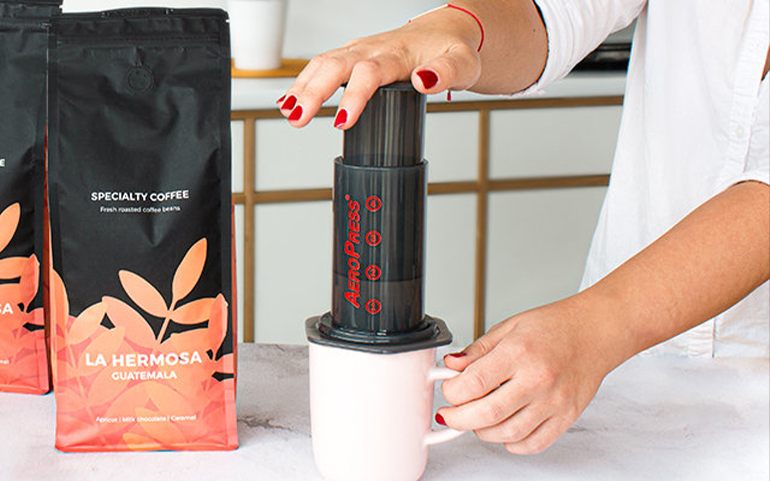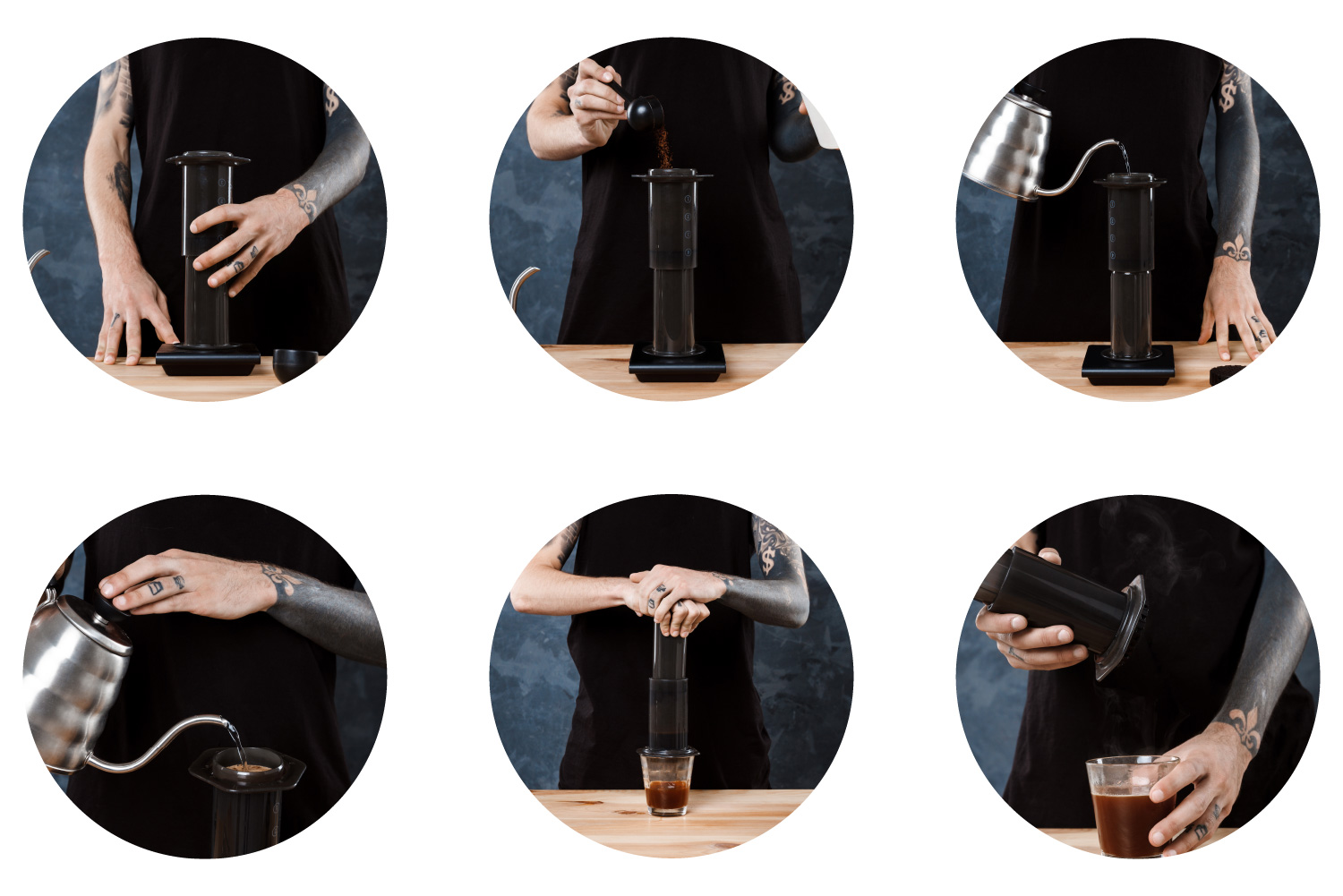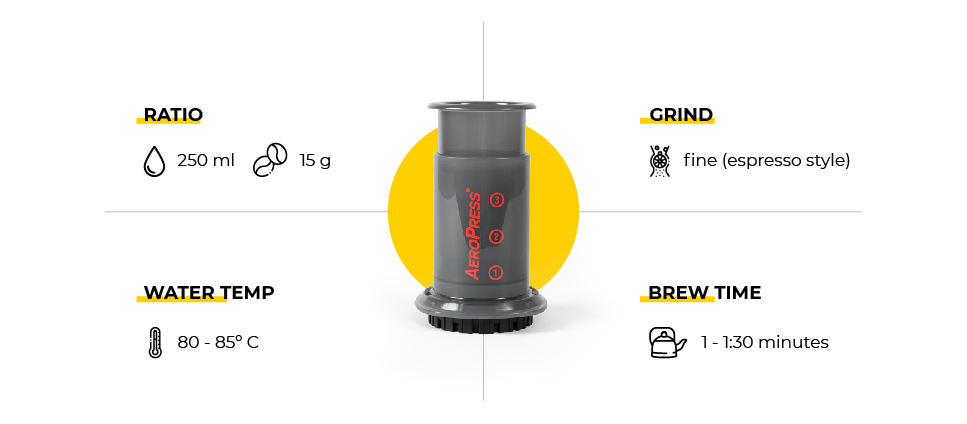How to Make Aeropress Coffee?

You could be forgiven for thinking that the Aeropress is a new type of exercise or a fancy industrial machine. But in fact, it’s a fascinating coffee maker, invented in 2005 by an ex-Stanford University engineering professor. The Aeropress Coffee Maker is a hand-held coffee press, used all around the world. It’s great for using ‘on the go’ whilst travelling, but it’s equally good in the kitchen or office.
Aeropress coffee – step by step guide
Here’s how to use Aeropress devices to make great coffee:
- Weigh out your coffee beans and grind them finely (around 13-15g is enough usually),
- Push the plunger out of the chamber, and put one of the new Aeropress filter papers in the filter cap (rinse it first to get rid of the paper taste and ensure a snug fit),
- Twist the cap onto the chamber,
- Stand the chamber on top of a mug and scoop your grounds into the chamber, ensuring they are level,
- Add boiling water up to the number 1 on the side of the chamber, stirring for 10 seconds,
- Insert the plunger; depress it gently, pausing when you feel resistance, until your plunger reaches the grounds at the bottom. Enjoy your Aeropress coffee!
- Always remove the filter cap after use, pushing the plunger through to get the used coffee out and rinse it all with clean water.

The beauty of the Aeropress coffee maker is that, although it’s simple to use (even if it looks complex when the instructions are written out), you can make a variety of coffees in it – espresso (drink as it is after pressing); Americano (add hot water to the top of the mug); or latté (add hot milk to the pressed coffee). You can even make a cold brew (add tap or iced water to the pressed brew). There is also an Aeropress travel version called the Aeropress Go.
Like any great invention with a devoted fan base, there are upgrades that you can make to the Aeropress coffee maker – like the Aeropress metal filter that is now widely available online. Although not sold by the manufacturer, the benefits include the fact that it is a reusable Aeropress filter which saves on paper waste, and can let through more of the essential natural oils in your Aeropress coffee, which paper filters may block.
Aeropress inverted method
The metal filter is particularly good when it comes to something called the Aeropress inverted method. Although it sounds technical, this simply means turning the Aeropress coffee maker upside down, meaning no water drips through the filter until you’re ready for it. What’s the advantage of an inverted Aeropress? Well, it means you mix up the coffee more as you turn it, and focusses on the immersion part of the brewing process a little more, giving you a slightly richer flavour.
Here’s some Aeropress instructions for the inverted method:
- Put your filter in the cap, and rinse
- Put the plunger into the main Aeropress chamber, so the open end of the chamber faces up towards you
- Put your grounds in and 50ml of boiled water
- Stir twice and wait for gases to be released and bubbles to form on the top
- Add another 170ml of hot water
- After 2 minutes, attach cap and filter and screw tightly
- Invert the Aeropress coffee maker so it sits on top of your mug
- Press down on the plunger slowly for about 30 seconds, then enjoy the brewed coffee!
Aeropress vs French Press
So, what are the benefits of an Aeropress coffee? How does it compare to its competitors? According to the manufacturer, it actually has just 1/9 of the acidity of a French press (also known as a cafetiere), and 1/5 of the acidity found with drip coffee. With a French press, the brew time is longer at around 4-5 minutes, and there is a risk of bitterness due to something called ‘over-extraction’. You can also get unpleasant grit in the cup. And have you noticed how hard it is to clean the cafetiere? The glass breaks very easily and the filter is awkward to rinse. Another competitor, the drip machine, also has a longer brew time, but you also have less control over water temperature, and sometimes end up discarding half of the coffee. Pods, on the other hand, are expensive and can harm the environment if they are not recyclable. Finally, espresso machines can be complex to use and expensive too, especially if they ever need repairing.
Best coffee for Aeropress?

Generally, try to use a finely ground coffee with your Aeropress, similar to an espresso grind – the finer the grind, the more surface area that the water can react with, and the richer the taste. Temperature matters too – use water of about 80 degrees Celsius for dark roasts, and slightly hotter (85 C) for medium roasts. And in terms of the ration of coffee to water when using an Aeropress, people find what works best for them, but generally an Aeropress ratio of 1:16 is favoured by many – for example, 15g of coffee for 250 ml of water.
Aeropress coffee maker review
There are many Aeropress coffee reviews online. You may see some talking about the Aerobie Aeropress coffee maker. This is because the company behind the product is called Aerobie – and that’s also the name of another of their products – an aerodynamic frisbee. As for the coffeemaker, its many fans of manual brewing say that they find it simple, well-designed, easy to clean, portable and that it makes great-tasting coffee. The manufacturer gives lots of helpful advice and interesting data on their website, including videos of handy Aeropress coffee instructions.
Troubleshooting
There are some common issues our clients report when starting to use Aeropress and ask for help with. We share some tips and advice on most commonly reported coffee troubles:
- If you’re thinking ‘why does my coffee taste sour?’ then it might be a sign that you’re ‘under-extracting’ (that’s the technical term for not getting enough flavour out of the brew). Try grinding it finer, or brewing it for longer.
- Another common question that some people ask is how to make coffee not taste bitter. If this is an issue for you then you may have the opposite problem to the one above. Try a coarser-grind, or start plunging the Aeropress sooner (meaning less brew time).
Quick-read summary
Q. What is an Aeropress coffee maker?
A. It’s a hand-held coffee-making product where you add coffee, hot water and then press it through a filter.
Q. Why should I buy one?
A. Many people find the coffee it makes is less acidic than coffee made in other products. Also, its quick, portable, easy to clean, and tastes good.
Q. Are there different versions of it?
A. Yes, there is an Aeropress travel version called the Aeropress Go, which comes with its own integrated mug, and is optimised for travelling, so that all the components fit inside it.
Q. What is the Aeropress inverted method and why should I try it?
A. It is a way of using the Aeropress turned upside-down, so that the coffee is mixed more. An inverted Aeropress also gives you better control over when the coffee begins to travel through the filter.
Q. How does the Aeropress coffee maker compare to other ways of making coffee?
A. It compares very favourably – its easier to clean than most other machines, its cheap, it’s simple to use and it’s much more portable than any other competitor.
Q. What do I do if the coffee tastes sour or bitter?
A. If you’re wondering ‘why does my coffee taste sour?’ then try grinding it finer and brewing for slightly longer. On the other hand, if you think your coffee is too bitter, then the solution is to brew for a shorter time, and grind it more coarsely.
Q. Any advice on how to use Aeropress?
A. Yes – read on for instructions and recipes for using the Aeropress!
